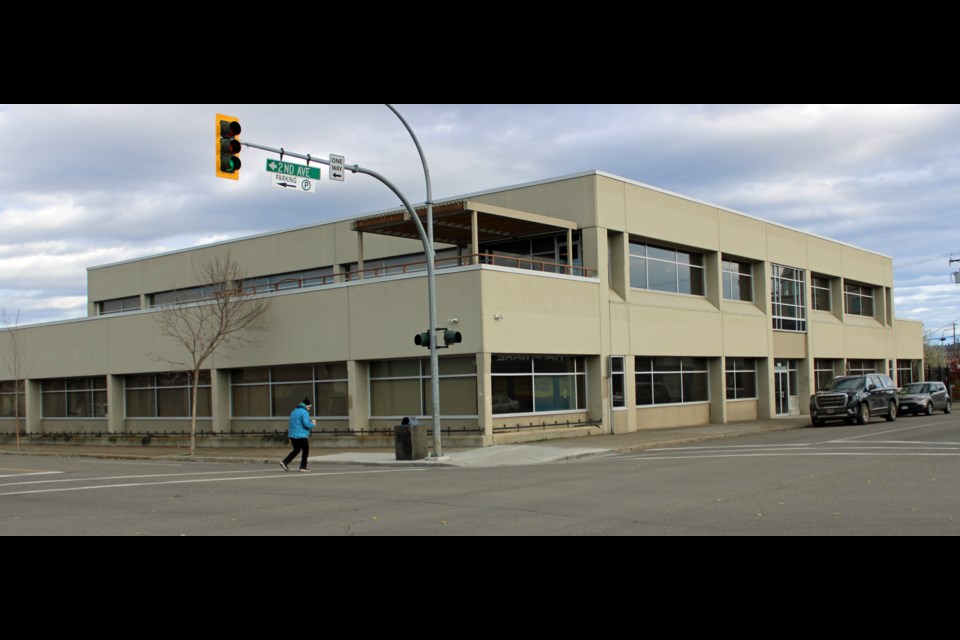Fortis BC Energy Inc. has applied to the British Columbia Utilities Commission to approve an application to sell Fortis’s customer service centre office building in downtown Prince George over concerns about crime and vagrancy in the area.
The building, at 1190 Second Ave., is adjacent to the St. Vincent de Paul Drop-in Centre which attracts dozens of the city’s unhoused and unsheltered street population who come for its daily meal service.
In a letter to the BCUC obtained by The Citizen, sent by Sarah Walsh, Fortis BC’s director of regulatory affairs, said the company intends to sell the Second Avenue building to Carrier Sekani Family Services.
Walsh explains why the company moved its customer service centre and corporate office in March to an alternate location out of the downtown core to a newly constructed building on the western edge of the Bowl area at 700 Kinsmen Pl.
“The environment around the Prince George Service Centre Office property location has deteriorated over the past years and the crime and disorganization in the area has become a risk to the facility and the mental and physical well-being of (Fortis) employees, as well as (Fortis’s) ability to continue to provide quality service to customers,” said Walsh.
“(Fortis) therefore determined that it was necessary to relocate the customer service centre to endure that (Fortis) could continue to provide quality customer service in a Prince George location without compromising the safety and health of its employees or the security of the facility.”
Walsh said the problem with increased crime and social disorganization has noticeably worsened over the past seven years. In response, Fortis stepped up security enhancements to try to improve the area around the property and also engaged in conversations about the deteriorating socioeconomic environment with community organizations, including the City of Prince George and Prince George RCMP.
A May 2019 security assessment revealed activities regularly observed near the centre’s main entrance on Second Avenue, including drug consumption, used drug paraphernalia left on the site, clear signs of urination and feces smearing in the entrance way, vandalism and property defacement and persistent loitering.
Over a five-month period from Jan. 2-May 27, 2019, Fortis employees witnessed 95 nuisance issues (loitering/trespassing/ removal of people; 18 incidents that resulted in police file numbers assigned; one physical threat to an employee from a member of the public; one suspicious package left on-site; three break and enter incidents (including a vehicle break-in the company parking lot; and two vandalism events.
Fortis’s security risk assessment made 10 recommendations, including installation of reception area double-doors, intercoms, security camaras, an on-premise security guard and personal alarm devices.
Despite those additional security measures, employees continued to experience negative and unsafe interactions with people in the area around the office, particularly when on breaks and entering or leaving the parking area. The situation continued to deteriorate to the point that routine activities of staff such as going for lunch or visiting their vehicles, particularly in the overflow parking lot, raised significant safety issues which impacted the mental and physical well-being of employees.
Vandalism and break-and-enter incidents continued and staff witnessed serious assaults and major medical incidents. Walsh said those experiences are not unique to the Fortis property and other business owners in the downtown area have experienced similar problems.
She said since the March 2024 move to the new building, employee response has been positive.
Fortis was known as Terasen Gas in 2010 when it paid $2.334 million to acquire the 20-year-old Second Avenue building for use as a customer service call centre. The company invested $5.63 million in capital improvements and resiliency upgrades to the two-story, 23,000 square-foot concrete structure and renovations were completed in April 2011.
Built to house one of two customer service centres in the province, the Prince George building was set up as one of the main hubs for the company’s network and communications system to provide redundancy in the event of a disaster at either location.
The renovation involved removing the existing mechanical heating/venting/air conditioning system and replacing it with a high-efficiency mechanical system. Control of the heating and cooling mechanical systems and the automated window coverings was set up for remote control by Fortis’s main office in the Lower Mainland. An uninterrupted power supply and generator system was also added to the building.
The interior office space was demolished and rebuilt to serve the needs of 100 full-time employees who worked there. Including renovations, the total cost of the property to Fortis was $7.8 million.
In January, Fortis hired A-Tech Appraisals to assess the value of the building and in the public report released earlier this month that value has been redacted.
After speaking with a real estate broker, Fortis determined there would be little interest in the building, given its location and the size of the facility. Fortis anticipated it would require conversion into a multi-tenant space or would have to be marketed at a significant discount.
Before it placed the building on the market, Fortis received offers from two community groups - Carrier Sekani Family Services (CSFS) and BC Housing - and accepted the highest offer, which came from CSFS.
On Oct. 7, Fortis filed with BCUC its application to sell the building to the Carrier Sekani Family Services Society.
As part of the regulatory process, Fortis is required by BCUC to show the sale of the downtown building will not result in any harm to its customers. The company believes it has met that obligation and the sale is in the public interest and should be approved.
If a public hearing is required for the review of the application, Fortis is confident that process will be minimal.



